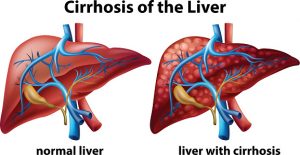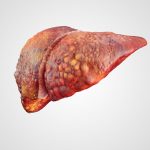 Ascites is an indicator of advanced liver disease and liver cirrhosis. Ascites is the accumulation of fluid in the abdominal cavity, separated by the diaphragm. Abdominal organs are contained in a sac called the peritoneum. There is normally no fluid found in this area, except in some women during menstrual cycles and even that is below an ounce. When fluid does fill up this area, it is abnormal and could be a sign of serious illness and a condition known as ascites.
Ascites is an indicator of advanced liver disease and liver cirrhosis. Ascites is the accumulation of fluid in the abdominal cavity, separated by the diaphragm. Abdominal organs are contained in a sac called the peritoneum. There is normally no fluid found in this area, except in some women during menstrual cycles and even that is below an ounce. When fluid does fill up this area, it is abnormal and could be a sign of serious illness and a condition known as ascites.
Why people with liver disease and cirrhosis develop ascites
 Individuals with chronic liver disease often develop fibrosis – scarring of the liver – which can lead to cirrhosis – a severe form of liver disease that can be deadly. Ascites is a complication of cirrhosis, which can lead to the abdomen swelling and bulging. The peritoneum covers abdominal organs, including the liver, which is probably why the two are associated.
Individuals with chronic liver disease often develop fibrosis – scarring of the liver – which can lead to cirrhosis – a severe form of liver disease that can be deadly. Ascites is a complication of cirrhosis, which can lead to the abdomen swelling and bulging. The peritoneum covers abdominal organs, including the liver, which is probably why the two are associated.
Advertisement
Ascites can occur due to two combining factors:
- There is an increase in pressure in the vein systems that carry blood from the stomach to the intestines, gallbladder and liver.
- There is a low level of the protein albumin that normally helps maintain healthy blood volume. This becomes reduced because cirrhosis damages the liver, which is responsible for producing it.
Causes and risk factors of ascites
Causes and risk factors of ascites are largely in part due to liver conditions, including:
- Cirrhosis
- Acute liver failure
- Budd-Chiari syndrome
- Liver cancer
- Hepatitis B or C
Other causes include:
- Heart failure
- Nephritic syndrome
- Pancreas disorders
- Direct irritation of the peritoneum
- Ovary disease
- Uncommonly found in hypothyroidism
- History of alcohol use
- Tuberculosis
Symptoms of ascites
Symptoms of ascites include:
 Sudden weight gain
Sudden weight gain- Swollen abdomen
- Difficulty breathing when lying down
- Diminished appetite
- Abdominal pain
- Bloating
- Nausea and vomiting
- Heartburn
Many of these symptoms are similar to other conditions, so diagnosis of ascites may be complicated at first. For proper diagnosis a doctor will perform the following tests.
- Ultrasound
- CT scan
- MRI
- Blood tests
- Laparoscopy
- Angiography
Prevention and treatment of ascites
Prevention of ascites includes the following lifestyle changes:
- Minimizing alcohol consumption – consuming in moderation
- Getting vaccinated for hepatitis B and C
- Practicing safe sex – hepatitis can be transmitted sexually
- Avoiding intravenous drug use
- Being aware of potential side effects associated with medications – if liver damage is listed, speak with your doctor about changing your medication
Treatment options include:
- Diuretics
- Paracentesis
- Surgery – a shunt may be put in to reroute blood flow to the liver
Natural home remedies for ascites
Some natural home remedies for ascites to consider:
 Garlic
Garlic- Radishes
- Fenugreek seeds
- Bitter gourd
- Onions
- Polytrichum juniperinum – juniper haircap moss
- Dandelion root
- Watermelon
These foods can help detox the body, reduce inflammation, work as a natural diuretic and help restore fluids to the body. Try to avoid drinking excess water, which can lead to additional swelling and weight gain.
Related Reading:
The one thing for a healthy liver
Liver-mortality has moved its way to being one of the top 12 causes of death within the United States. Nonalcoholic fatty liver disease (NAFLD) has risen to be the most common form of liver disease in the Western world. Continue reading…
Advertisement
Foods that help liver regeneration
Did you know there are foods that can help promote liver regeneration? Did you also know the liver is the only organ in the body which can regenerate? It’s true. You may have heard that a starfish can grow back a missing limb, and lizards can grow back their tails; similarly, if a part of the liver is damaged it can partake in liver regeneration. Continue reading…
Sources:
http://www.medicinenet.com/ascites/article.htm#what_is_ascites
http://www.emedicinehealth.com/ascites/article
http://www.medicinenet.com/edema
http://www.emedicinehealth.com/ascites
http://www.healthline.com/symptom/ascites
http://www.findhomeremedy.com/10-natural-cures-for-ascites
https://www.organicfacts.net/home-remedies/home-remedies-for-ascites
